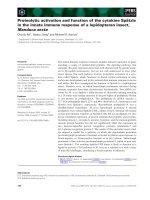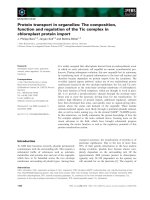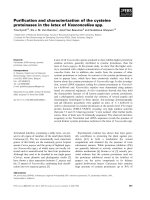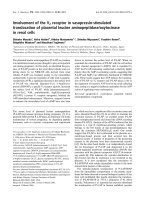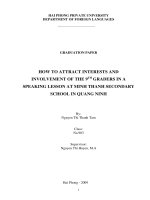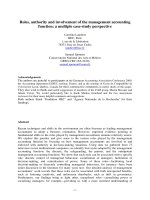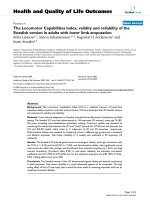SOME TECHNIQUES TO ATTRACT INTERESTS AND INVOLVEMENT OF THE 9TH GRADERS IN a SPEAKING LESSON AT NGHI XUAN SECONDARY SCHOOL IN NGHE AN
Bạn đang xem bản rút gọn của tài liệu. Xem và tải ngay bản đầy đủ của tài liệu tại đây (1.61 MB, 64 trang )
i
MINISTRY OF EDUCATION AND TRAINING
VINH UNIVERSITY
PHAN THANH XUAN
SOME TECHNIQUES TO ATTRACT INTERESTS AND
INVOLVEMENT OF THE 9TH GRADERS IN A SPEAKING LESSON
AT NGHI XUAN SECONDARY SCHOOL IN NGHE AN
Major: Teaching English to Speakers of Other Languages (TESOL)
Code: 60.14.01.11
MASTER’S THESIS IN EDUCATION
Supervisor:
Assoc.Prof: NGO DINH PHUONG
VINH, 2017
i
Acknowledgements
This work would not have been possible without the support of Mr Ngo
Dinh Phuong, my supervisor, for her guidance, great suggestions and advice in
each step of the study. Who have been supportive of my career goals and who
worked actively
to provide me with the protected academic time to pursue
those goals. Without her precious comments, academic instructions and
wholehearted help, my research would have never been accomplished.
Also,I am really grateful to all teachers in Foreign Language department,
Vinh University for their useful lectures and suggestions.
Besides, I would especially like to thank all teachers and students in Nghi
Xuan secondary school for their enthusiasm in finishing the survey
questionnaires.
Last but not least, I am grateful to my family and friends who have given
me much encouragement during the time I carried out this paper.
ii
ABSTRACT
The purpose of this study was to investigate the students ‘attitudes toward
a speaking lesson and suggest some effective techniques for teaching speaking
skill. The research was carried out at Nghi Xuan secondary school over 160
tenth grade students divided into two groups. The experimental group was
taught in the lessons using suggested techniques. The control group was taught
in the lessons used current techniques
Data for the research was collected from reference, questionnaires, and
interviews. Finding from these instruments reveals that using interesting
techniques can increase students ‘motivation in speaking lesson. It is
recommended that teachers should use many techniques to motivate students in
learning.
iii
Table of Contents
MINISTRY OF EDUCATION AND TRAINING....................................................................................................... i
VINH UNIVERSITY............................................................................................................................................ i
MASTER’S THESIS IN EDUCATION..................................................................................................................... i
Acknowledgements......................................................................................................................................... i
Table of Contents........................................................................................................................................... iii
CHAPTER 1: INTRODUCTION........................................................................................................................... 1
1. Reason of study.......................................................................................................................................... 1
2. Aims of the study........................................................................................................................................ 2
3. Scope of the study...................................................................................................................................... 2
4. Methods of the study................................................................................................................................. 3
5. Research questions..................................................................................................................................... 3
6. Design of the study..................................................................................................................................... 3
CHAPTER 2: LITERATURE REVIEW................................................................................................................... 5
I. Speaking skill: A general view...................................................................................................................... 5
1. Definition of speaking skill.......................................................................................................................... 5
2. Types of speaking....................................................................................................................................... 6
3. Features of a successful speaking activity................................................................................................... 7
II. Teaching speaking....................................................................................................................................... 8
1. The importance of speaking skill................................................................................................................. 8
2. Why don’t students feel much interested in speaking skill?........................................................................9
3. Factors to attract students’ involvements in English speaking lessons.......................................................10
4. Activities to promote students’ speaking.................................................................................................. 11
CHAPTER 3: METHODOLY............................................................................................................................. 14
I. Real situation............................................................................................................................................. 14
II. Survey questionnaires.............................................................................................................................. 16
1. Participants.............................................................................................................................................. 16
2. Aims of the survey questionnaires............................................................................................................ 16
3. Structure of the survey questionnaires..................................................................................................... 17
CHAPTER 4: FINDINGS AND DISCUSSION...................................................................................................... 18
I. Data and analysis....................................................................................................................................... 18
Table 1: Students’ English learning time........................................................................................................ 18
Table 1: The most favourite lesson to students’ view.................................................................................... 19
Chart 2: Students’ opinions toward speaking lessons.................................................................................... 20
iv
Table 4: Effectiveness of adopted techniques in pre-speaking.......................................................................21
Table 9: Students’ and teachers’ opinions about students’ difficultieswhen speaking in class.......................22
II. Findings and discussion............................................................................................................................ 22
III. Some suggested techniques to attract interests and involvement of the 9th graders in a speaking lesson at
Nghi Xuan school in Nghe An........................................................................................................................ 24
1. Making sentence...................................................................................................................................... 24
2. Face to face activity.................................................................................................................................. 25
3. Hot seat activity........................................................................................................................................ 28
4. Pictures description.................................................................................................................................. 29
5. Discussing................................................................................................................................................. 31
6. Teaching through songs............................................................................................................................ 32
7. Comparing pictures.................................................................................................................................. 33
8. Explaining the words................................................................................................................................ 35
9. Role play................................................................................................................................................... 36
10. Speaking in topic.................................................................................................................................... 38
11. Telling story............................................................................................................................................ 39
12. Debate.................................................................................................................................................... 40
13. Talk show................................................................................................................................................ 41
Part III: Conclusion........................................................................................................................................ 50
Attachment.................................................................................................................................................. 51
1
CHAPTER 1: INTRODUCTION
1. Reason of study
English has become a vital and mandatory communication language in
Vietnam since the opening of its doors to the world in 1986. Many Englishspeaking foreigners from across Asia, Australia, America and Europe started
coming to invest in Vietnam. This has motivated the people of Vietnam to learn
English to facilitate efficient and effective communication among their
counterparts. The importance of English was immediately acknowledged by the
Vietnamese government and as a result the English language programs were
made compulsory beginning with the secondary schools and subsequently the
high schools and finally university.
The teaching of English in secondary and high schools strongly focus
mainly on grammar, sentence structures and vocabulary. In such a teaching
format, conversational English was not taken into consideration. In addition,
English learning and teaching is purely examination-based. Examinations were
mainly grammar-focused. As a result, the teachers and academicians teach only
the bare necessity which is required to pass the examination and is not linked to
the learning needs of individual students. This has caused students to become
de-motivated because English is just another subject at school, not part of their
life. Many students eventually fail to see the importance and pride in being able
to speak fluent English.
Today, of the four English basic skills (listening, speaking, reading and
writing), it is thought that speaking seems to play the most important role:
knowing-language-people are considered “speaker” of that language as if
speaking included all four kinds of knowing. Classroom activities that help to
develop learners ability in expressing themselves would play an important part
in a language course
2
The goal of teaching speaking, surely, is to improve the oral production of
the students. Along with international integration trend, students should improve
and promote their communication skill so that they can express themselves and
learn to follow the social and cultural rules appropriating in each communicative
circumstances. In order to do that, language-teaching activities in the classroom
should aim at maximizing individual language use. Teachers’ role is not only to
create a warm and friendly classroom but also to provide students with effective
and plentiful activities. Only by such way can those activities encourage
students to speak and attract them to speaking lessons.
These factors mentioned above have aroused my ambition to carry out the
study of “some techniques to attract interests and involvements of 9 th graders in
a speaking lesson at Nghi Xuan secondary school in Nghe An province”.
2. Aims of the study
The study is carried out to research:
* Firstly, the study studies the different aspects of speaking skill that
serves as overview, the features and characteristics of teaching speaking skill.
* Secondly, the study surveys the real situation of teaching Englishspeaking skill in 9th form in Nghi Xuan secondary school.
* The last also the most important aim is to suggest some effective
techniques that can be applied in Nghi Xuan secondary school to attract
students’ interest sand involvements in speaking lessons.
3. Scope of the study
* Actually, attracting students’ interests and involvements needs to be
done in teaching all four basic skills (listening, speaking, reading, and writing).
However, it is impractical to overspread such a large scope I a graduation paper.
Thus, the study limits itself to:
3
* Finding out the reality of teaching English speaking skill for 9 th form
students in Nghi Xuan secondary schools
* Offering appropriate techniques to attract 9th graders in Nghi Xuan
secondary school in speaking lessons
4. Methods of the study
First, a survey is conducted for three 9 th classes in Nghi Xuan
secondary school with a point of view to find out their difficulties they
encounter and what are their favorite activities in learning speaking skill
Second, reference books about speaking and methodology are reviewed
to get background knowledge of what speaking is, successful and interesting
techniques in teaching speaking.
Third, more information needed for the findings of the survey will be
gathered from formal and informal interview with the surveyed teachers and
students.
5. Research questions
5.1. What are students’ attitudes toward used current techniques in
speaking lesson?
5.2. How may these techniques interest students’ in speaking activities?
6. Design of the study
The study consists of five chapters
Chapter 1: Introduction
This chapter shows reasons to choose the study, the aims, scope, methods,
and design of the study.
Chapter 2: Literature review
This chapter aims to answer the questions related to speaking that
introduces the speaking skill and its features.
4
Chapter 3: Methodology
The real situation of teaching speaking skill in Nghi Xuan secondary
school and a study on how speaking lessons are thought by students in Nghi
xuan secondary school in Nghe An
Chapter 4: Finding and discussion
The analysis and the findings obtain from survey questionnaires made to
9th form students of Nghi Xuan secondary school.
“Suggested techniques to attract students ‘interests and involvement in a
speaking lesson” mention techniques and a sample lesson of using different
activities in each part of a speaking lesson to attract secondary students to a
speaking lesson”
Chapter 5: Conclusion summarizes the discussed parts in the paper and
somesuggestions for further study.
As a result, Chapter I has mentioned the content of the study. In the next
part, the author will present the focus of the study including her literature review
on the understanding of speaking skill and the survey questionnaires for students
of Nghi xuan secondary school which help examine the real situation of teaching
and learning speaking.
5
CHAPTER 2: LITERATURE REVIEW
I. Speaking skill: A general view
Speaking skill is the art of communications and one of four productive
skill, that must mastered in learning foreign languages. Good speaking skill is
the act of generating words that can be understood by listeners. A good speakers
is clear and informative
1. Definition of speaking skill
Speaking is the skill that students will be judged most in real life
situations. It is an important part of everyday interaction and most often the first
impression of a person is based on his or her ability to speak fluently and
comprehensively. However, speaking is in many ways an undervalued skill.
This, perhaps, is because we can almost all speak, and so have the low opinion
of it. Speaking is often thought of as a popular form of expressions. Speaking,
on the contrary, is a skill which deserves attention a bit as much as literacy skill.
Our learners often need to speak with confidence in order to carry out many of
their basic transactions. “Speaking”, as Harris (1977:81) says, “is a complex
skill requiring the simultaneous use of different abilities developed at the
different rates”.
John (1982) believes that speaking ability is regarded the measure of
knowing a language. The learners define speaking as the most important skill
they can acquire. They assess their progress in term of their accomplishment in
spoken communication.
Besides, Bygate observes: speaking is the skill by which learners are most
frequently judged and through which they make or lose friends. It is the medium
through which much of language is learnt and which for many is particularly
conductive for learning”. Bygate emphasizes the importance of speaking, not
6
only for performing basic translations, but also for establishing and maintaining
social relationships.
In general, speaking is an interactive process of constructing meaning that
involves producing and receiving and processing information (Brown, 1994;
Burns & Joyce, 1997). Its form and meaning are dependent on the context in
which it occurs, including the participant themselves, their collective
experiences, the physical environment and the purpose for speaking.
2. Types of speaking
In speaking class, according to Burns, A & Joyce, H. (1997), students
must be exposed to three key items:
2.1 Form-focused speaking
Form-focused instruction, that is, attention to details of pronunciation,
grammar, vocabulary, and so forth…
When learners begin speaking in another language, their speaking will
need to be based on some form-focused learning. An effective way to start is to
base speaking on some useful, simple memorized phrases and sentences. These
may be greetings, simple personal description, and simple questions and
answers. As their proficiency and experience in the language develop, most of
these sentences and phrases may be re-analyzed and incorporated into the
learners’ system of knowledge of the language. Language use based on
memorization can be the starting point for more creative use of the language.
2.2 Meaning-focused speaking
Meaning-focused instruction, that is, opportunities to produce meaningful
spoken messages with real communicative purposes
In addition to form-focused speaking, language learners should be
exposed to and given chances to practice and use meaning-focused
7
communication, in which they must both produce and listen to meaningful oral
communication.
2.3 Opportunities to improve fluency
Elements of all these above should be presented throughout a speaking
program with emphasis on form-focused instruction at the elementary levels and
as the learners progress on meaning-focused instruction at the higher level.
3. Features of a successful speaking activity
According to
the book: 1987. Testing Spoken Language. London:
Cambridge University Press, a successful speaking activity is characterized as
below.
3.1. Students talk a lot
As much as possible period of time allotted to the activity occupied by
students talk. This is obvious, but often most time is taken up with teacher talks
or pauses. It means the students must be active to speak with their friends as
much as possible. It is very clear that the students are busy, but they seldom
spent their time to talk with their teacher.
3.2. Participation is even
Classroom discussion is not dominated by a monitory of talkative
participants: all get a chance to speak, and contributions are fairly evenly
distributed. It means that the classroom discussion is not dominated by one
participant only, but all of participants get a same chance to speak.
3.3. Motivation is high
Students are eager to speak: because they are interested in the topic and
have something new to say about it, or because they want to contribute to
achieve an objective task. It means that the students have high motivation to
speak English. By having a high motivation, the students will be interested in
8
learning English, especially in speaking. They often try to deliver their own idea
confidently.
3.4. Language is of an acceptable level
Students express themselves in utterances that are relevant, easily
comprehensible to each other, and of an acceptable level of language accuracy. It
means that they use the components of speaking which are relevant with the
acceptable level of language such as, pronunciation, grammar, fluency, and
comprehensible. So, the students often try to speaking English correctly in real
communication.
II. Teaching speaking
1. The importance of speaking skill.
Language is a tool for communication. We communicate with others, to
express our ideas, and to know others’ ideas as well. Communication takes
place, where there is speech. Without speech we cannot communicate with one
another. The importance of 3/10speaking skills, hence is enormous for the
learners of any language. Without speech, a language is reduced to a mere script.
The use of language is an activity which takes place within the confines of our
community. We use language in a variety of situations. People at their work
places, i.e. researchers working either in a medical laboratory or in a language
laboratory, are supposed to speak correctly and effectively in-order to
communicate well with one another. Any gap in commutation results in
misunderstandings and problems.
As you know, the speaking skill is quite difficult so the teaching of skill
has become increasingly important. Since when we communicate, we use the
language to accomplish some functions such as greeting, asking, arguing or
promising within social context.
9
If the students don’t learn how to speak or don’t get the chance to speak,
they will soon get de-motivated and lose interests in learning. Therefore, the
teaching of speaking should start right from the first lesson of English that
students have which can make the lesson more interesting, dynamic and even
funny for the students.
2. Why don’t students feel much interested in speaking skill?
2.1. Being compulsory
Most students realize how important it is for their future. The real
problem is providing choice and differentiating instruction. Teachers need to
allow students more control and allow them to study how, what and even when
they want.
2.2. Getting so embarrassed trying to speak English in class.
Most language classrooms have very differing levels of language learners.
Those not at the top of the fluency ladder get very ashamed and stressed when
trying to speak English in a classroom.
2.3. Being boring
Despite all the talk online and among innovative language teachers, the
truth is that the grammar syllabus and approach still rules in this world. Millions
of students each day start by repeating endless lines of correct grammar and
continue by filling in reams of fill in the blanks worksheets. Language is taught
as a subject not a skill like art, gym, typing or music. This must stop.
2.4. Teachers’ pronunciation
Pronunciation also plays a very important role in learning a language, as
Derwing and Munro (2005) claimed that, "having good pronunciation of the
language can help in normal communication, particularly intelligibility" (as cited
in Nation & Newton, 2009. p. 75).When teaching English speaking lesson, the
way that teachers pronounce will impress students in some extends and
10
contribute to lesson success. Students are often confused with soft dull voice of
teachers. It will become worse if teachers pronounce words incorrectly because
it leads to students’ mistakes. And if teachers‟ teaching methods are not
attractive at all, students will rapidly feel bored with speaking lessons and
teachers as well. Therefore, it is necessary for teachers to pay attention to their
pronunciation.
3. Factors to attract students’ involvements in English speaking
lessons
“Teaching is one of the easiest jobs in the world. Teaching well is one of
the most difficult”.
(From: Teachers Joe-Super teachers –Book for Middle school and High
school Teachers of English.mht-Teaching idea for the ESL classroom)
+ Reduce your TTT (Teacher Talking Time) in the classroom, by giving
simple and clear instructions, by asking one or two students to show (by means
of speaking) that they understood the task instructions, and also by asking other
students to answer a student's question.
+ Increase STT (Student Talking Time), again, by asking other students to
answer a student's question, by showing pictures related to the topic of the class
and, without saying a single word, eliciting students' participation.
+ Avoiding yes/no questions; prefer those questions that make students
speak in order to make themselves clear.
+ Attention to your way of correcting students. Sometimes, even when
your intention is simply to help a certain student, you may make things even
worse to them.
+ When watching student A for mistakes, don't be so close to them
because this will make them even shier. Instead, get close to another student or
11
simply stand back or pretend being interested in something different, picking up
a book or going back to your
4. Activities to promote students’ speaking.
4.1. Why teachers should give students a variety of speaking
activities?
It is important to provide the students with a variety of speaking activities
because: A variety of speaking activities will enable students to cope with
different situations in reality.
Variety helps keep motivation high because any kind of activity, if
overused, may become less interesting.
Variety may suit students of different learning styles because each student
has his own learning style so some kinds of activities may suit some students
while others may suit other students.
4.2. Simple tips for teachers to have a successful speaking activity.
Here are four ways you can generate interest in a speaking activity :
( provided by )
+ Make competition by dividing class into some groups.
This will
motivate the competitive ability of students and will be less stressful for shy
students than speaking in front of the class
+ Create the funny and attractive speaking activities with clear purposes
by using the pictures. The students must see a reason to communicate with
others. This can encourage students to talk well
+ Change the dynamics of the classroom, change the layout or ask the
students to move into different groups.
+ Explain the activities carefully and clear. If students don’t understand
the rule of activities, they will be less likely to talk
If you follow these simple tips, you're sure to have a successful speaking
activity.
12
4.3. Activities to promote speaking
To make students fluency in speaking English, they must regard English
as matter of habit. Therefore, they must have appropriate activities. Here are
some activities which can help student to be great in speaking English.
Kayi (2006: 2) states that there are some activities to promote speaking.
They are explained as follows:
4.3.1 Discussion
The students may aim to arrive at a conclusion, share ideas about an
event, or find solutions in their discussion groups. Here the teacher can form
groups of students and each group works on their topic for a given time period,
and present their opinions to the class. Fauziati (2002: 134) states that the main
aim of group discussion is to improve fluency, grammar in probably best
allowed functioning as a naturally communicative context.
4.3.2 Role Play and Simulation
Role play has appeal for students because it allows the students to be
creative and to put themselves in another person’s place for a while (Richard,
2003: 222). While simulation is very similar to role-play but here students can
bring items to the class to create a realistic environment. For instance, if a
student is acting as a singer, he or she can bring a microphone to sing and so on.
4.3.3 Interviews
Conducting interviews with people gives students a chance to practice
their speaking ability not only in class but also outside and helps them becoming
socialized. After interviews, each student can present the result to the class.
4.3.4 Reporting
In class, the students are asked to report what they find as the most
interest
news.
Students
can
also
talk
about
whether
they
have
experiencedanything worth telling their friends in their daily lives before class.
13
4.3.5 Prepared Talks
A popular kind of activity is the prepared talk where a student makes a
presentation on a topic. Such talks are not designed for informal spontaneous
conversation; because they are prepared, they are more ‘writing-like’ than
spoken orally. However, if possible, students should speak from notes rather
than from a script (Harmer, 2001: 274)
4.3.6 Dialogue
Dialogue is one of the media in teaching speaking. It helps the students
practice in speech, pronunciation, intonation, stress. Dialogue also increases
students’ vocabulary. The primary objective of using dialogue is developing
student’s competence (pronunciation, intonation, stress) in teaching speaking
like native speaker. Therefore, in teaching-learning uses dialogue (short and
long), the students are motivated by the teachers question to reason rather than
to recollect. Dialogues is two sides communication, it means we just not have to
express something but we should have to understand what another peoples said
(Podo and Sulaiman, 1995: 25). When we teach young learners we constantly
have to keep in mind the fact what he have in front of us is a mixed class with
varied abilities, expectations, motivation level, knowledge and last but not least,
different learning styles. Thus, we need to vary our approaches and offer as
much opportunity as possible to make the whole class find a little something to
hold on to, expand and grow (Klancar, 2006).
To sum up, Chapter 1 has provided us with the background knowledge of
speaking in general and teaching speaking in particular. In the Chapter 2, we
will investigate how speaking lessons are dealt with by teachers and students in
Nghi Xuan secondary school in Nghe An province thanks to survey
questionnaire.
14
CHAPTER 3: METHODOLY
I. Real situation
The survey was conducted in Nghi Xuan secondary school in Nghe An
province and found its reality. The survey questionnaires have been focused on
the features of teachers and students in the school with the reality in teaching
and learning also, and based on textbook: English 9.
1.1 Students
There are about 650 students that divided into 17 classes, in which about
170 students in 4 classes are learning in 9th grade. Most of them have been
learning English from 3rd grade; moreover, some students got acquainted with
English from their primary education.
Besides, they are quite good at learning English even English skill. They
know the importance of English language in their life; however, they seem to
pay attention to written English form more than speaking form. This is partly
due to the fact that all of them have to learn in order to pass the exam.
1.2 Teaching speaking methods in Nghi Xuan secondary school
currently
Teachers don’t use any other teaching aids such as power point, pictures
or projects, exception for textbooks. Therefore, I found that the current methods
in each English period seem to be poor and the atmosphere find a little bit
boring.
1.3 Teaching and learning condition
The teaching and learning condition in Nghi Xuan secondary school is
fairly good with a system of the new blackboards, the equipments are modern:
the furniture is right in size. However, there aren’t many illustrations English
pictures for studying, that is why in English periods the class atmosphere is not
funny. In this school, there is also a library where teachers and students can
15
borrow books, magazines and newspapers. However, teaching aids to study
English in this school are inadequate. In class time, teachers often use visual
aids but they are not rich. That’s why their lectures don’t attract students’
attention ant it appears quite boring to the students.
Furthermore, there are 4 of 9th grades; each of them consists of about 38 to
43 students so it is a little bit difficult for teachers to keep discipline in class.
1.4 English teaching teachers
Nghi Xuan secondary school has 6 English teaching teachers, all of them
graduated from university and have experience in teaching English. All of them
always prepare their lectures carefully and thoughtfully, however, sometimes
they still keep the traditional teaching methods: focusing on teaching grammar
not communication, so this at times prevents students from developing their
communicative skill.
1.5 The English textbook
The textbook adopted by the school for 9th graders is designed by Ministry
of Education and Training, with 9six clear parts:
Getting started: introduces the overall of lesson by using pictures,
suggesting knowledge, discussing in group, questioning…..
Listening and reading : presents a 200 words text that helps students get
acquainted with the theme of the unit.
Speaking: improves speaking skill by using group work, pair work,
individual work…. Of course, students communicate up to linguistic function
and the theme of each unit.
Reading: it gives a reading text with some exercises to help
students improve their reading skill
Listening: it gives a text or a dialogue related to the topic of the
unit. It helps students to check pronunciation and develop listening skill.
16
Writing: this part has many exercises that can support students‟
writing skill to different types of paragraphs such as: letter, narration, data
description….
Language focus: it shows the grammar refers to grammatical
structures and vocabularies that focused in that unit is
Every lesson is edited to have three steps: pre-, while-, post-, each o
which has different functions and acquires different techniques.
II. Survey questionnaires
1. Participants
18 survey questionnaires were completed by 170 9 th graders in Nghi
Xuan secondary school in Nghe An province.
2. Aims of the survey questionnaires
With a view to provide a thorough insight into the real situations of
teaching speaking, survey within the scope of the study is conducted in Nghi
Xuan secondary school. The main aim of the study is to collect and analyze data
regarding the recognition and utilization of speaking. The survey questionnaires
are designed for the following purposes:
To make out the attitude of students and teachers toward English
teaching and learning in general and a speaking lesson in particular.
To get more information about the situation of teaching speaking
skill in 9th form classes in Nghi Xuan secondary school.
To get to know students’ problems as well as expectations toward
techniques applied in the speaking classes.
Finally, thanks to these, techniques on using funny activities to attract
students’ interests and involvements in speaking periods will be found out.
17
3. Structure of the survey questionnaires
The survey questionnaires consist of 5 questions are raised to students
learning speaking skill in Nghi Xuan secondary school. Students were asked to
tick the most suitable answers which correspond with their opinion. The
questionnaires are designed as below:
Question 1+2: studying on students‟ attitude toward Englishlessons in
general and speaking lessons in particular as well as kinds of working in
speaking activities.
Question : Students’ opinions on current used techniques and their
effectiveness in teaching speaking
18
CHAPTER 4: FINDINGS AND DISCUSSION
This chapter mentions the results and analysis of the data from survey
questionnaires and Some suggested techniques to attract interests and
involvement of the 9th graders in a speaking lesson at Nghi Xuan school in
Nghe An
I. Data and analysis
1.1. Students’ English learning time (Question 1)
Table 1: Students’ English learning time
The table above indicates how long the 9th graders studied English in Nghi
Xuan secondary school. The data shows that almost students have been studied
English early from elementary school. Only a few students have just got access
to English.
19
4.2. Students’ and teachers’ opinions on English skill in general and
speaking lessons in particular.
4.2.1 Student’ interests in learning English skills (Question 2)
Speaking
Writing
Reading
Listening
Total
60%
13%
17%
10%
100%
Table 1: The most favourite lesson to students’ view
The aim of this question is to research which English skill students like
most. We can easily see that among the four skills is speaking with the
percentage of 60% while the listening skill is only made up 10%.
The data show that speaking skill get attention from students while the
two skills reading and writing make up: 17% and 13%. It means that the
importance of speaking skill is highly appreciated by students. From the figures,
it’s clear to see that almost students have been acquired to study English early
from elementary school. Very few students have just learnt English. It is likely
there would be not many differences in their levels.
1.2. Students’ opinions toward speaking lessons.
(Question 3)
Because more than half of students prefer speaking lesson, it is clear that a
large number of students find the speaking lesson interesting, even very
interesting. Thus, teachers can find the ways and activities to encourage students
in learning speaking skills. However, there is only a small percentage of students
who prefer other skills instead. There are many reasons for this figure. First, in
every secondary school, most teachers pay much attention to teach grammar but
20
not to listening. Second, Vietnamese teachers’ voice makes students not very
interested in. Moreover, when learning listening in class, students often hear
from CD, cassette… in which the native foreigners speak quite fast with so
many homophones, accents… so it is very difficult for students to catch the
words and understand what the speakers mean.
It raises a questions whether speaking lessons make students pleasant or
excited or not.
Chart 2: Students’ opinions toward speaking lessons
1.3.
Students’
opinions
on
current
used
techniques
and
theireffectiveness inteaching speaking ( Question 4)
The table 4 will give us the answer of effectiveness of adopted techniques
in speaking
Techniques
Questions
Students
Effective Normal
Not very
effective
30%
65%
5%
Matching
68%
27%
Games
90%
10%
45%
47%
Information gap
5%
8%

